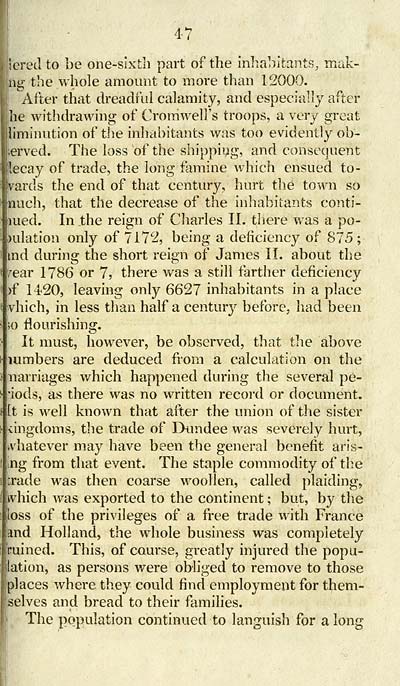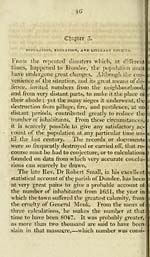Towns > Dundee > 1822 - Dundee delineated; or, A history and description of that town, its institutions, manufactures and commerce
(49)
Download files
Complete book:
Individual page:
Thumbnail gallery: Grid view | List view

47
ered to be one-sixth part of the Inhabitants, rtiak-
g the whole amount to more than 12000.
After that dreadful calamity, and especially after
he withdrawing of Cromwell's troops, a very great
iminution of the inhabitants was too evidently ob-
erved. The loss of the shipping, and consequent
ecay of trade, the long famine which ensued to-
ards the end of that century, hurt the town so
nuch, that the decrease of the inhabitants conti-
nued. In the reign of Charles II. there was a po-
lulation only of 7172, being a deficiency of 875 ;
tnd during the short reign of James II. about the
fear 1786 or 7, there was a still farther deficiency
bf 1420, leaving only 6627 inhabitants in a place
vhich, in less than half a century before, had been
;o flourishing.
It must, however, be observed, that the above
lumbers are deduced from a calculation on the
fnarriages v/hich happened during the several pe-
iods, as there was no written record or document.
[t is well known that after the union of the sister
kingdoms, the trade of Dundee was severely hurt,
whatever may have been the general benefit aris-
ng from that event. The staple commodity of the
xade was then coarse woollen, called plaiding,
which was exported to the continent ; but, by the
loss of the privileges of a free trade with France
and Holland, the whole business was completely
mined. This, of course, greatly injured the popu-
lation, as persons were obliged to remove to those
Iplaces where they could find employment for them-
elves and bread to their families.
The population continued to languish for along
ered to be one-sixth part of the Inhabitants, rtiak-
g the whole amount to more than 12000.
After that dreadful calamity, and especially after
he withdrawing of Cromwell's troops, a very great
iminution of the inhabitants was too evidently ob-
erved. The loss of the shipping, and consequent
ecay of trade, the long famine which ensued to-
ards the end of that century, hurt the town so
nuch, that the decrease of the inhabitants conti-
nued. In the reign of Charles II. there was a po-
lulation only of 7172, being a deficiency of 875 ;
tnd during the short reign of James II. about the
fear 1786 or 7, there was a still farther deficiency
bf 1420, leaving only 6627 inhabitants in a place
vhich, in less than half a century before, had been
;o flourishing.
It must, however, be observed, that the above
lumbers are deduced from a calculation on the
fnarriages v/hich happened during the several pe-
iods, as there was no written record or document.
[t is well known that after the union of the sister
kingdoms, the trade of Dundee was severely hurt,
whatever may have been the general benefit aris-
ng from that event. The staple commodity of the
xade was then coarse woollen, called plaiding,
which was exported to the continent ; but, by the
loss of the privileges of a free trade with France
and Holland, the whole business was completely
mined. This, of course, greatly injured the popu-
lation, as persons were obliged to remove to those
Iplaces where they could find employment for them-
elves and bread to their families.
The population continued to languish for along
Set display mode to: Large image | Transcription
Images and transcriptions on this page, including medium image downloads, may be used under the Creative Commons Attribution 4.0 International Licence unless otherwise stated. ![]()
| Scottish Post Office Directories > Towns > Dundee > Dundee delineated; or, A history and description of that town, its institutions, manufactures and commerce > (49) |
|---|
| Permanent URL | https://digital.nls.uk/85824619 |
|---|
| Description | Directories of individual Scottish towns and their suburbs. |
|---|
| Description | Around 700 Scottish directories published annually by the Post Office or private publishers between 1773 and 1911. Most of Scotland covered, with a focus on Edinburgh, Glasgow, Dundee and Aberdeen. Most volumes include a general directory (A-Z by surname), street directory (A-Z by street) and trade directory (A-Z by trade). |
|---|


